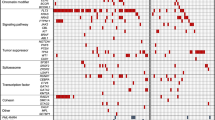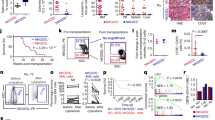Abstract
Among a variety of immunodeficient mouse strains the nonobese diabetic (NOD)/LtSz scid/scid strain appears to be most useful in allowing the engraftment of human AML. However, the large variability in ability to engraft and the levels of engraftment reached have not been explained. To address these issues we have investigated the NOD/SCID repopulating ability of 27 newly diagnosed AML samples. Patients were selected for the absence of internal tandem duplications in the Flt3 gene as we previously reported this mutation to be associated with an enhanced engraftment potential in this model. We observed that secondary AML (n = 6) had a significantly increased level of engraftment when compared to primary AML (n = 21, median levels 73.3% for secondary AML vs 8.94% for primary AML, P = 0.01). Within the primary AML, a significantly higher engraftment was observed in the FAB class M0 than in FAB classes M2, M4 and M5. Within primary AML, samples of patients who failed to respond to the initial therapy gave rise to a higher level of engraftment than samples of patients who did respond to therapy. A similar observation of an increased engraftment correlating with a poorer patient prognosis could be made when applying cytogenetic risk stratification. However, within the primary AML the most important clinical parameter correlating with the level of engraftment appeared to be the patient's WBC count at diagnosis (P = 0.0000). Covariate analysis with the WBC count as a covariate could also fully explain the differences observed in the cytogenetic risk groups, or on the basis of the initial therapy response. Although large differences could be observed, the ability to engraft the NOD/SCID mice was not linked to either the autonomous or cytokine-induced proliferation in vitro. As the leukemic cobblestone area-forming cell frequencies also revealed no correlation with repopulation in the NOD/SCID model, we consider it very likely that the level of engraftment reflects the in vivoproliferative ability of the AML samples assayed rather than the number of leukemia-initiating cells infused into the NOD/SCID mice. Phenotypic analysis based on the expression of CD33, CD34 and CD38 before and after passage in NOD/SCID showed that in 10 out of 16 samples investigated phenotypes were different. In summary, in addition to the Flt3 internal tandem duplications we have identified a series of clinical parameters that determine the NOD/SCID repopulating ability of AML samples, whilst our data strongly suggest that AML in NOD/SCID does not reflect the leukemic process in the patient.
This is a preview of subscription content, access via your institution
Access options
Subscribe to this journal
Receive 12 print issues and online access
$259.00 per year
only $21.58 per issue
Buy this article
- Purchase on Springer Link
- Instant access to full article PDF
Prices may be subject to local taxes which are calculated during checkout







Similar content being viewed by others
References
Griffin JD, Lowenberg B . Clonogenic cells in acute myeloblastic leukemia Blood 1986 68: 1185–1195
Vellenga E, Griffin JD . The biology of acute myeloblastic leukemia Semin Oncol 1987 14: 365–371
Keinanen M, Griffin JD, Bloomfield CD, Machnicki J, de la Chapelle A . Clonal chromosomal abnormalities showing multiple-cell-lineage involvement in acute myeloid leukemia New Engl J Med 1988 318: 1153–1158
Terpstra W, Prins A, Ploemacher RE, Wognum BW, Wagemaker G, Lowenberg B, Wielenga JJ . Long-term leukemia-initiating capacity of a CD34-subpopulation of acute myeloid leukemia Blood 1996 87: 2187–2194
Terpstra W, Ploemacher RE, Prins A, van Lom K, Pouwels K, Wognum AW, Wagemaker G, Lowenberg B, Wielenga JJ . Fluorouracil selectively spares acute myeloid leukemia cells with long-term growth abilities in immunodeficient mice and in culture Blood 1996 88: 1944–1950
Blair A, Hogge DE, Sutherland HJ . Most acute myeloid leukemia progenitor cells with long-term proliferative ability in vitro and in vivo have the phenotype CD34(+)/CD71(−)/HLA-DR Blood 1998 92: 4325–4335
Cashman J, Bockhold K, Hogge DE, Eaves AC, Eaves CJ . Sustained proliferation, multi-lineage differentiation and maintenance of primitive human haemopoietic cells in NOD/SCID mice transplanted with human cord blood Br J Haematol 1997 98: 1026–1036
Hogan CJ, Shpall EJ, McNiece I, Keller G . Multilineage engraftment in NOD/LtSz-scid/scid mice from mobilized human CD34% peripheral blood progenitor cells Biol Blood Marrow Transplant 1997 3: 236–246
Archer DR, Turner CW, Yeager AM, Fleming WH . Sustained multilineage engraftment of allogeneic hematopoietic stem cells in NOD/SCID mice after in utero transplantation Blood 1997 90: 3222–3229
Verstegen MM, Cornelissen JJ, Terpstra W, Wagemaker G, Wognum AW . Multilineage outgrowth of both malignant and normal hemopoietic progenitor cells from individual chronic myeloid leukemia patients in immunodeficient mice Leukemia 1999 13: 618–628
Wang JC, Lapidot T, Cashman JD, Doedens M, Addy L, Sutherland DR, Nayar R, Laraya P, Minden M, Keating A, Eaves AC, Eaves CJ, Dick JE . High level engraftment of NOD/SCID mice by primitive normal and leukemic hematopoietic cells from patients with chronic myeloid leukemia in chronic phase Blood 1998 91: 2406–2414
Lewis ID, McDiarmid LA, Samels LM, To LB, Hughes TP . Establishment of a reproducible model of chronic-phase chronic myeloid leukemia in NOD/SCID mice using blood-derived mononuclear or CD34+ cells Blood 1998 91: 630–640
Terpstra W, Prins A, Visser T, Wognum B, Wagemaker G, Lowenberg B, Wielenga J . Conditions for engraftment of human acute myeloid leukemia (AML) in SCID mice Leukemia 1995 9: 1573–1577
Lowry PA, Shultz LD, Greiner DL, Hesselton RM, Kittler EL, Tiarks CY, Rao SS, Reilly J, Leif JH, Ramshaw H, Stewart FM, Quesenberry PJ . Improved engraftment of human cord blood stem cells in NOD/LtSz-scid/scid mice after irradiation or multiple-day injections into unirradiated recipients Biol Blood Marrow Transplant 1996 2: 15–23
Lapidot T, Fajerman Y, Kollet O . Immune-deficient SCID and NOD/SCID mice models as functional assays for studying normal and malignant human hematopoiesis J Mol Med 1997 75: 664–673
Bonnet D, Dick JE . Human acute myeloid leukemia is organized as a hierarchy that originates from a primitive hematopoietic cell Nature Med 1997 3: 730–737
French–American–British (FAB) Cooperative group . Proposed revised criteria for the classification of acute myeloid leukemia Ann Intern Med 1985 103: 620–685
Vellenga E, van Putten WL, Boogaerts MA, Daenen SM, Verhoef GE, Hagenbeek A, Jonkhoff AR, Huijgens PC, Verdonck LF, van der Lelie J, Schouten HC, Gmur J, Wijermans P, Gratwohl A, Hess U, Fey MF, Lowenberg B . Peripheral blood stem cell transplantation as an alternative to autologous marrow transplantation in the treatment of acute myeloid leukemia? Bone Marrow Transplant 1999 23: 1279–1282
Lowenberg B, Boogaerts MA, Daenen SM, Verhoef GE, Hagenbeek A, Vellenga E, Ossenkoppele GJ, Huijgens PC, Verdonck LF, van der Lelie J, Wielenga JJ, Schouten HC, Gmur J, Gratwohl A, Hess U, Fey MF, van Putten WL . Value of different modalities of granulocyte–macrophage colony-stimulating factor applied during or after induction therapy of acute myeloid leukemia J Clin Oncol 1997 15: 3496–3506
Lowenberg B, Suciu S, Archimbaud E, Ossenkoppele G, Verhoef GE, Vellenga E, Wijermans P, Berneman Z, Dekker AW, Stryckmans P, Schouten H, Jehn U, Muus P, Sonneveld P, Dardenne M, Zittoun R . Use of recombinant GM-CSF during and after remission induction chemotherapy in patients aged 61 years and older with acute myeloid leukemia: final report of AML-11, a phase III randomized study of the Leukemia Cooperative Group of European Organisation for the Research and Treatment of Cancer and the Dutch Belgian Hemato-Oncology Cooperative Group Blood 1997 90: 2952–2961
Mrozek K, Heinonen K, de la Chapelle A, Bloomfield CD . Clinical significance of cytogenetics in acute myeloid leukemia Semin Oncol 1997 24: 17–31
Grimwade D, Walker H, Oliver F, Wheatley K, Harrison C, Harrison G, Rees J, Hann I, Stevens R, Burnett A, Goldstone A . The importance of diagnostic cytogenetics on outcome in AML: analysis of 1612 patients entered into the MRC AML 10 trial. The Medical Research Council Adult and Children's Leukaemia Working Parties Blood 1998 92: 2322–2333
Delwel R, Salem M, Pellens C, Dorrsers L, Wagemaker G, Clark S, Lowenberg B . Growth regulation of human acute myeloid leukemia: effects of five recombinant hematopoietic factors in a serum-free culture system Blood 1988 72: 1944–1949
Breems DA, Blokland EA, Neben S, Ploemacher RE . Frequency analysis of human primitive haematopoietic stem cell subsets using a cobblestone area forming cell assay Leukemia 1994 8: 1095–1104
Ploemacher RE, van der Sluijs JP, Voerman JS, Brons NH . An in vitro limiting-dilution assay of long-term repopulating hematopoietic stem cells in the mouse Blood 1989 74: 2755–2763
Ailles LE, Gerhard B, Kawagoe H, Hogge DE . Growth characteristics of acute myelogenous leukemia progenitors that initiate malignant hematopoiesis in nonobese diabetic/severe combined immunodeficient mice Blood 1999 94: 1761–1772
Rombouts WJC, Blokland I, Löwenberg B, Ploemacher RE . Biological characteristics and prognosis of adult acute myeloid leukemia with internal tandem duplications in the Flt3 gene Leukemia 2000 14: 675–683
Acknowledgements
This project was financed by the Dutch platform for alternatives in animal research (PAD) grant No.: VWS/PAD 9625. The authors would like to thank the staff of the bone marrow transplantation unit of the department for their help in obtaining the thymidine incorporation data. They also would like to thank J Brandenburg, E van Bodegom and A van‘t Hof for the excellent animal husbandry and care for our mice.
Author information
Authors and Affiliations
Rights and permissions
About this article
Cite this article
Rombouts, W., Martens, A. & Ploemacher, R. Identification of variables determining the engraftment potential of human acute myeloid leukemia in the immunodeficient NOD/SCID human chimera model. Leukemia 14, 889–897 (2000). https://doi.org/10.1038/sj.leu.2401777
Received:
Accepted:
Published:
Issue Date:
DOI: https://doi.org/10.1038/sj.leu.2401777
Keywords
This article is cited by
-
A foretaste for pediatric glioblastoma therapy: targeting the NF-kB pathway with DHMEQ
Child's Nervous System (2023)
-
An improved pre-clinical patient-derived liquid xenograft mouse model for acute myeloid leukemia
Journal of Hematology & Oncology (2017)
-
Heterogeneity of clonal expansion and maturation-linked mutation acquisition in hematopoietic progenitors in human acute myeloid leukemia
Leukemia (2014)
-
Establishment of xenotransplantation model of human CN-AML with FLT3-ITD mut /NPM1 − in NOD/SCID mice
Journal of Huazhong University of Science and Technology [Medical Sciences] (2013)
-
Establishment of reproducible xenotransplantation model of T cell acute lymphoblastic leukemia in NOD/SCID mice
Journal of Huazhong University of Science and Technology [Medical Sciences] (2012)



